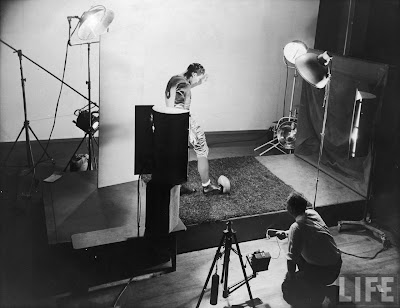House party
Harold E. Edgerton
Hammer smashing light bulb, 1933
Harold Eugene "Doc" Edgerton
1903 - 1990
Profesor de ingeniería eléctrica en el Instituto de Tecnología de Massachusetts nacido en Fremont, Nebraska al que se le acredita en gran parte con la transformación del estroboscopio de un instrumento de laboratorio oscuro en un dispositivo común.
Su comienzo fué de la mano de la inspiracion que le dió Charles Stark Draper para fotografiar objetos cotidianos con flash electrónico: la primera fue el chorro de aguade un grifo.
En 1937 se asocia con el fotografo Gjon Mili utilizando el equipo estroboscópico, en particular, las unidades múltiples de estudio flash electrónico para realizar bellas fotografias y siendo pioneros en el uso de fotografias para eventos rapidos.
Tuvo un papel importante en la fotografía y el registro de los ensayos nucleares de los Estados Unidos a través de los años cincuenta y sesenta y colaboró con el submarinista Jacques Cousteau en el diseño de los equipos subacuáticos de fotografía con flash electrónico y mas tarde desarroyó las tecnicas del sonar submarino para el descubrimiento del buque Britannic.
En 1940, su cortometraje de alta velocidad estroboscópica "Quicker'n a Wink" ganó un Oscar por sus efectos de imagenralentizada que el ojo humano no es capaz de captar.
Football kick 1934
Professor of electrical engineering at the Massachusetts Institute of Technology was born in Fremont, Nebraska who is largely credited with transforming the stroboscope from an obscure laboratory instrument into a common device.
Its beginning was from the hand of the inspiration that gave Charles Stark Draper to photograph everyday objects with electronic flash: the first was the stream of water from a faucet.
In 1937 he associated with the photographer Gjon Mili using strobe equipment, including multiple units of studio electronic flash for beautiful photographs and pioneering the use of photographs for fast events.
Played an important role in photography and recording nuclear tests the United States through the fifties and sixties and worked with the diver Jacques Cousteau in the design of underwater equipment for electronic flash photography and later unfoldment the submarine sonar techniques for the discovery of the ship Britannic.
In 1940 his short film high-speed strobe "Quicker'n to Wink" won an Oscar for its effects imagenralentizada the human eye can not grasp.
Death of a light bulb 1936
Densmore Shute Bends the Shaft 1936
Jim Dotson Hits the Softball 1938
Tennis Player 1938
Pete Desjardin Diving, 1940
The Penlight Drawings, 1949
Milk drop coronete 1957
Bullet trhough three balloons 1959
Self-Portrait with Balloon and Bullet, 1959
Gus Solomons 1960
Shooting the apple 1964
Card hit by a 30 calibre bullet, 1970
Harold E. Edgerton, scuba-diving under Calypso
Salvador dalí
Harold Eugene "Doc" Edgerton
1903 - 1990
Profesor de ingeniería eléctrica en el Instituto de Tecnología de Massachusetts nacido en Fremont, Nebraska al que se le acredita en gran parte con la transformación del estroboscopio de un instrumento de laboratorio oscuro en un dispositivo común.
Su comienzo fué de la mano de la inspiracion que le dió Charles Stark Draper para fotografiar objetos cotidianos con flash electrónico: la primera fue el chorro de aguade un grifo.
En 1937 se asocia con el fotografo Gjon Mili utilizando el equipo estroboscópico, en particular, las unidades múltiples de estudio flash electrónico para realizar bellas fotografias y siendo pioneros en el uso de fotografias para eventos rapidos.
Tuvo un papel importante en la fotografía y el registro de los ensayos nucleares de los Estados Unidos a través de los años cincuenta y sesenta y colaboró con el submarinista Jacques Cousteau en el diseño de los equipos subacuáticos de fotografía con flash electrónico y mas tarde desarroyó las tecnicas del sonar submarino para el descubrimiento del buque Britannic.
En 1940, su cortometraje de alta velocidad estroboscópica "Quicker'n a Wink" ganó un Oscar por sus efectos de imagenralentizada que el ojo humano no es capaz de captar.
Football kick 1934
Professor of electrical engineering at the Massachusetts Institute of Technology was born in Fremont, Nebraska who is largely credited with transforming the stroboscope from an obscure laboratory instrument into a common device.
Its beginning was from the hand of the inspiration that gave Charles Stark Draper to photograph everyday objects with electronic flash: the first was the stream of water from a faucet.
In 1937 he associated with the photographer Gjon Mili using strobe equipment, including multiple units of studio electronic flash for beautiful photographs and pioneering the use of photographs for fast events.
Played an important role in photography and recording nuclear tests the United States through the fifties and sixties and worked with the diver Jacques Cousteau in the design of underwater equipment for electronic flash photography and later unfoldment the submarine sonar techniques for the discovery of the ship Britannic.
In 1940 his short film high-speed strobe "Quicker'n to Wink" won an Oscar for its effects imagenralentizada the human eye can not grasp.
Death of a light bulb 1936
Densmore Shute Bends the Shaft 1936
Jim Dotson Hits the Softball 1938
Tennis Player 1938
Pete Desjardin Diving, 1940
The Penlight Drawings, 1949
Milk drop coronete 1957
Bullet trhough three balloons 1959
Self-Portrait with Balloon and Bullet, 1959
Gus Solomons 1960
Shooting the apple 1964
Card hit by a 30 calibre bullet, 1970
Harold E. Edgerton, scuba-diving under Calypso
Salvador dalí















































No hay comentarios:
Publicar un comentario